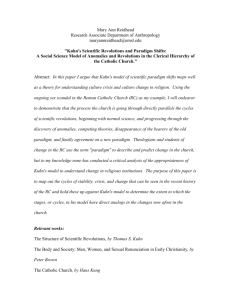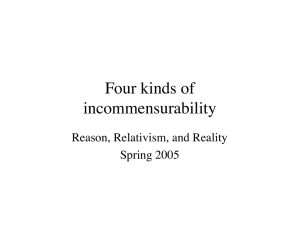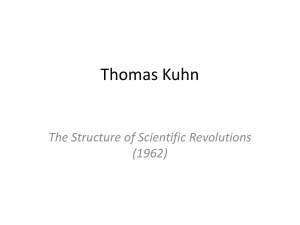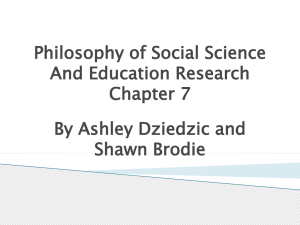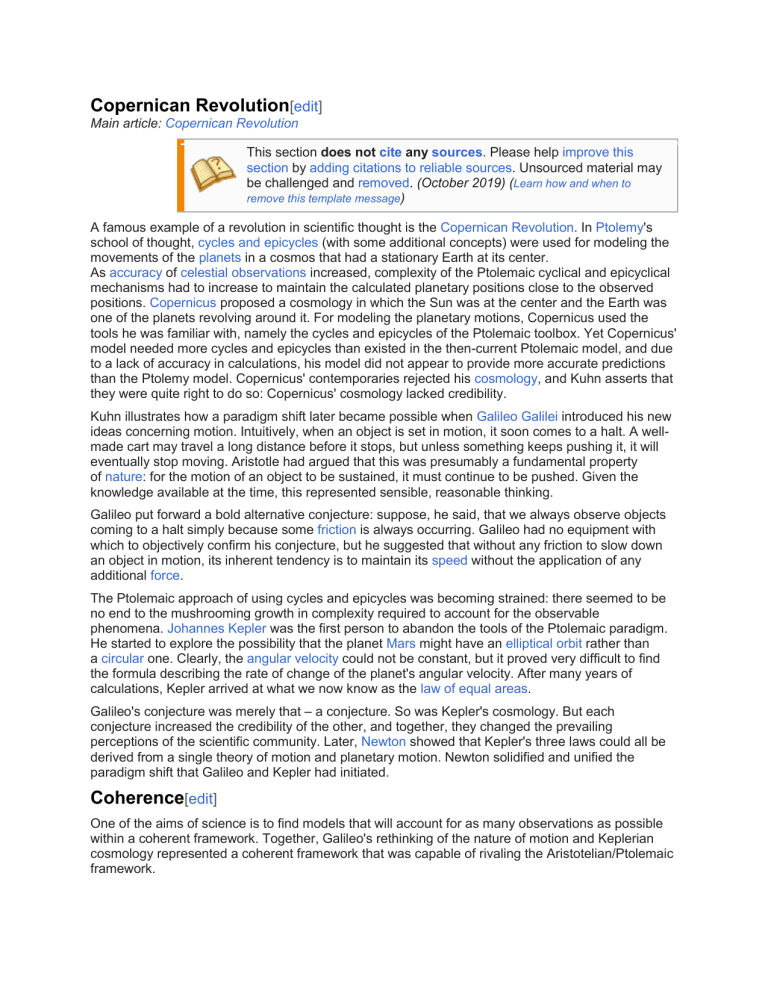
Copernican Revolution[edit] Main article: Copernican Revolution This section does not cite any sources. Please help improve this section by adding citations to reliable sources. Unsourced material may be challenged and removed. (October 2019) (Learn how and when to remove this template message) A famous example of a revolution in scientific thought is the Copernican Revolution. In Ptolemy's school of thought, cycles and epicycles (with some additional concepts) were used for modeling the movements of the planets in a cosmos that had a stationary Earth at its center. As accuracy of celestial observations increased, complexity of the Ptolemaic cyclical and epicyclical mechanisms had to increase to maintain the calculated planetary positions close to the observed positions. Copernicus proposed a cosmology in which the Sun was at the center and the Earth was one of the planets revolving around it. For modeling the planetary motions, Copernicus used the tools he was familiar with, namely the cycles and epicycles of the Ptolemaic toolbox. Yet Copernicus' model needed more cycles and epicycles than existed in the then-current Ptolemaic model, and due to a lack of accuracy in calculations, his model did not appear to provide more accurate predictions than the Ptolemy model. Copernicus' contemporaries rejected his cosmology, and Kuhn asserts that they were quite right to do so: Copernicus' cosmology lacked credibility. Kuhn illustrates how a paradigm shift later became possible when Galileo Galilei introduced his new ideas concerning motion. Intuitively, when an object is set in motion, it soon comes to a halt. A wellmade cart may travel a long distance before it stops, but unless something keeps pushing it, it will eventually stop moving. Aristotle had argued that this was presumably a fundamental property of nature: for the motion of an object to be sustained, it must continue to be pushed. Given the knowledge available at the time, this represented sensible, reasonable thinking. Galileo put forward a bold alternative conjecture: suppose, he said, that we always observe objects coming to a halt simply because some friction is always occurring. Galileo had no equipment with which to objectively confirm his conjecture, but he suggested that without any friction to slow down an object in motion, its inherent tendency is to maintain its speed without the application of any additional force. The Ptolemaic approach of using cycles and epicycles was becoming strained: there seemed to be no end to the mushrooming growth in complexity required to account for the observable phenomena. Johannes Kepler was the first person to abandon the tools of the Ptolemaic paradigm. He started to explore the possibility that the planet Mars might have an elliptical orbit rather than a circular one. Clearly, the angular velocity could not be constant, but it proved very difficult to find the formula describing the rate of change of the planet's angular velocity. After many years of calculations, Kepler arrived at what we now know as the law of equal areas. Galileo's conjecture was merely that – a conjecture. So was Kepler's cosmology. But each conjecture increased the credibility of the other, and together, they changed the prevailing perceptions of the scientific community. Later, Newton showed that Kepler's three laws could all be derived from a single theory of motion and planetary motion. Newton solidified and unified the paradigm shift that Galileo and Kepler had initiated. Coherence[edit] One of the aims of science is to find models that will account for as many observations as possible within a coherent framework. Together, Galileo's rethinking of the nature of motion and Keplerian cosmology represented a coherent framework that was capable of rivaling the Aristotelian/Ptolemaic framework. Once a paradigm shift has taken place, the textbooks are rewritten. Often the history of science too is rewritten, being presented as an inevitable process leading up to the current, established framework of thought. There is a prevalent belief that all hitherto-unexplained phenomena will in due course be accounted for in terms of this established framework. Kuhn states that scientists spend most (if not all) of their careers in a process of puzzle-solving. Their puzzle-solving is pursued with great tenacity, because the previous successes of the established paradigm tend to generate great confidence that the approach being taken guarantees that a solution to the puzzle exists, even though it may be very hard to find. Kuhn calls this process normal science. As a paradigm is stretched to its limits, anomalies – failures of the current paradigm to take into account observed phenomena – accumulate. Their significance is judged by the practitioners of the discipline. Some anomalies may be dismissed as errors in observation, others as merely requiring small adjustments to the current paradigm that will be clarified in due course. Some anomalies resolve themselves spontaneously, having increased the available depth of insight along the way. But no matter how great or numerous the anomalies that persist, Kuhn observes, the practicing scientists will not lose faith in the established paradigm until a credible alternative is available; to lose faith in the solvability of the problems would in effect mean ceasing to be a scientist. In any community of scientists, Kuhn states, there are some individuals who are bolder than most. These scientists, judging that a crisis exists, embark on what Kuhn calls revolutionary science, exploring alternatives to long-held, obvious-seeming assumptions. Occasionally this generates a rival to the established framework of thought. The new candidate paradigm will appear to be accompanied by numerous anomalies, partly because it is still so new and incomplete. The majority of the scientific community will oppose any conceptual change, and, Kuhn emphasizes, so they should. To fulfill its potential, a scientific community needs to contain both individuals who are bold and individuals who are conservative. There are many examples in the history of science in which confidence in the established frame of thought was eventually vindicated. It is almost impossible to predict whether the anomalies in a candidate for a new paradigm will eventually be resolved. Those scientists who possess an exceptional ability to recognize a theory's potential will be the first whose preference is likely to shift in favour of the challenging paradigm. There typically follows a period in which there are adherents of both paradigms. In time, if the challenging paradigm is solidified and unified, it will replace the old paradigm, and a paradigm shift will have occurred. Phases[edit] Kuhn explains the process of scientific change as the result of various phases of paradigm change. Phase 1 – It exists only once and is the pre-paradigm phase, in which there is no consensus on any particular theory. This phase is characterized by several incompatible and incomplete theories. Consequently, most scientific inquiry takes the form of lengthy books, as there is no common body of facts that may be taken for granted. If the actors in the pre-paradigm community eventually gravitate to one of these conceptual frameworks and ultimately to a widespread consensus on the appropriate choice of methods, terminology and on the kinds of experiment that are likely to contribute to increased insights.[13] Phase 2 – Normal science begins, in which puzzles are solved within the context of the dominant paradigm. As long as there is consensus within the discipline, normal science continues. Over time, progress in normal science may reveal anomalies, facts that are difficult to explain within the context of the existing paradigm.[14] While usually these anomalies are resolved, in some cases they may accumulate to the point where normal science becomes difficult and where weaknesses in the old paradigm are revealed.[15] Phase 3 – If the paradigm proves chronically unable to account for anomalies, the community enters a crisis period. Crises are often resolved within the context of normal science. However, after significant efforts of normal science within a paradigm fail, science may enter the next phase.[16] Phase 4 – Paradigm shift, or scientific revolution, is the phase in which the underlying assumptions of the field are reexamined and a new paradigm is established.[17] Phase 5 – Post-revolution, the new paradigm's dominance is established and so scientists return to normal science, solving puzzles within the new paradigm.[18] A science may go through these cycles repeatedly, though Kuhn notes that it is a good thing for science that such shifts do not occur often or easily. Incommensurability[edit] According to Kuhn, the scientific paradigms preceding and succeeding a paradigm shift are so different that their theories are incommensurable—the new paradigm cannot be proven or disproven by the rules of the old paradigm, and vice versa. (A later interpretation by Kuhn of 'commensurable' versus 'incommensurable' was as a distinction between languages, namely, that statements in commensurable languages were translatable fully from one to the other, while in incommensurable languages, strict translation is not possible.[19]) The paradigm shift does not merely involve the revision or transformation of an individual theory, it changes the way terminology is defined, how the scientists in that field view their subject, and, perhaps most significantly, what questions are regarded as valid, and what rules are used to determine the truth of a particular theory. The new theories were not, as the scientists had previously thought, just extensions of old theories, but were instead completely new world views. Such incommensurability exists not just before and after a paradigm shift, but in the periods in between conflicting paradigms. It is simply not possible, according to Kuhn, to construct an impartial language that can be used to perform a neutral comparison between conflicting paradigms, because the very terms used are integral to the respective paradigms, and therefore have different connotations in each paradigm. The advocates of mutually exclusive paradigms are in a difficult position: "Though each may hope to convert the other to his way of seeing science and its problems, neither may hope to prove his case. The competition between paradigms is not the sort of battle that can be resolved by proofs. (p. 148)" Scientists subscribing to different paradigms end up talking past one another. Kuhn states that the probabilistic tools used by verificationists are inherently inadequate for the task of deciding between conflicting theories, since they belong to the very paradigms they seek to compare. Similarly, observations that are intended to falsify a statement will fall under one of the paradigms they are supposed to help compare, and will therefore also be inadequate for the task. According to Kuhn, the concept of falsifiability is unhelpful for understanding why and how science has developed as it has. In the practice of science, scientists will only consider the possibility that a theory has been falsified if an alternative theory is available that they judge credible. If there is not, scientists will continue to adhere to the established conceptual framework. If a paradigm shift has occurred, the textbooks will be rewritten to state that the previous theory has been falsified. Kuhn further developed his ideas regarding incommensurability in the 1980s and 1990s. In his unpublished manuscript The Plurality of Worlds, Kuhn introduces the theory of kind concepts: sets of interrelated concepts that are characteristic of a time period in a science and differ in structure from the modern analogous kind concepts. These different structures imply different "taxonomies" of things and processes, and this difference in taxonomies constitutes incommensurability.[20] This theory is strongly naturalistic and draws on developmental psychology to "found a quasitranscendental theory of experience and of reality."[21] Exemplar[edit] Kuhn introduced the concept of an exemplar in a postscript to the second edition of The Structure of Scientific Revolutions (1970). He noted that he was substituting the term 'exemplars' for 'paradigm', meaning the problems and solutions that students of a subject learn from the beginning of their education. For example, physicists might have as exemplars the inclined plane, Kepler's laws of planetary motion, or instruments like the calorimeter.[22][23] According to Kuhn, scientific practice alternates between periods of normal science and revolutionary science. During periods of normalcy, scientists tend to subscribe to a large body of interconnecting knowledge, methods, and assumptions which make up the reigning paradigm (see paradigm shift). Normal science presents a series of problems that are solved as scientists explore their field. The solutions to some of these problems become well known and are the exemplars of the field.[24][25] Those who study a scientific discipline are expected to know its exemplars. There is no fixed set of exemplars, but for a physicist today it would probably include the harmonic oscillator from mechanics and the hydrogen atom from quantum mechanics.[26] Kuhn on scientific progress[edit] The first edition of The Structure of Scientific Revolutions ended with a chapter titled "Progress through Revolutions", in which Kuhn spelled out his views on the nature of scientific progress. Since he considered problem solving to be a central element of science, Kuhn saw that for a new candidate paradigm to be accepted by a scientific community, First, the new candidate must seem to resolve some outstanding and generally recognized problem that can be met in no other way. Second, the new paradigm must promise to preserve a relatively large part of the concrete problem solving ability that has accrued to science through its predecessors.[27] While the new paradigm is rarely as expansive as the old paradigm in its initial stages, it must nevertheless have significant promise for future problem-solving. As a result, though new paradigms seldom or never possess all the capabilities of their predecessors, they usually preserve a great deal of the most concrete parts of past achievement and they always permit additional concrete problem-solutions besides.[28][verification needed] In the second edition, Kuhn added a postscript in which he elaborated his ideas on the nature of scientific progress. He described a thought experiment involving an observer who has the opportunity to inspect an assortment of theories, each corresponding to a single stage in a succession of theories. What if the observer is presented with these theories without any explicit indication of their chronological order? Kuhn anticipates that it will be possible to reconstruct their chronology on the basis of the theories' scope and content, because the more recent a theory is, the better it will be as an instrument for solving the kinds of puzzle that scientists aim to solve. Kuhn remarked: "That is not a relativist's position, and it displays the sense in which I am a convinced believer in scientific progress."[29][30] Influence and reception[edit] The Structure of Scientific Revolutions has been credited with producing the kind of "paradigm shift" Kuhn discussed.[4] Since the book's publication, over one million copies have been sold, including translations into sixteen different languages.[31] In 1987, it was reported to be the twentieth-century book most frequently cited in the period 1976–1983 in the arts and the humanities.[32] Philosophy[edit] The first extensive review of The Structure of Scientific Revolutions was authored by Dudley Shapere, a philosopher who interpreted Kuhn's work as a continuation of the anti-positivist sentiment of other philosophers of science, including Paul Feyerabend and Norwood Russell Hanson. Shapere noted the book's influence on the philosophical landscape of the time, calling it "a sustained attack on the prevailing image of scientific change as a linear process of ever-increasing knowledge".[33] According to the philosopher Michael Ruse, Kuhn discredited the ahistorical and prescriptive approach to the philosophy of science of Ernest Nagel's The Structure of Science (1961).[34] Kuhn's book sparked a historicist "revolt against positivism" (the so-called "historical turn in philosophy of science" which looked to the history of science as a source of data for developing a philosophy of science),[35] although this may not have been Kuhn's intention; in fact, he had already approached the prominent positivist Rudolf Carnap about having his work published in the International Encyclopedia of Unified Science.[36] The philosopher Robert C. Solomon noted that Kuhn's views have often been suggested to have an affinity to those of Georg Wilhelm Friedrich Hegel.[37] Kuhn's view of scientific knowledge, as expounded in The Structure of Scientific Revolutions, has been compared to the views of the philosopher Michel Foucault.[38] Sociology[edit] The first field to claim descent from Kuhn's ideas was the sociology of scientific knowledge.[39] Sociologists working within this new field, including Harry Collins and Steven Shapin, used Kuhn's emphasis on the role of non-evidential community factors in scientific development to argue against logical empiricism, which discouraged inquiry into the social aspects of scientific communities. These sociologists expanded upon Kuhn's ideas, arguing that scientific judgment is determined by social factors, such as professional interests and political ideologies.[40] Barry Barnes detailed the connection between the sociology of scientific knowledge and Kuhn in his book T. S. Kuhn and Social Science.[41] In particular, Kuhn's ideas regarding science occurring within an established framework informed Barnes's own ideas regarding finitism, a theory wherein meaning is continuously changed (even during periods of normal science) by its usage within the social framework.[42][43] The Structure of Scientific Revolutions elicited a number of reactions from the broader sociological community. Following the book's publication, some sociologists expressed the belief that the field of sociology had not yet developed a unifying paradigm, and should therefore strive towards homogenization. Others argued that the field was in the midst of normal science, and speculated that a new revolution would soon emerge. Some sociologists, including John Urry, doubted that Kuhn's theory, which addressed the development of natural science, was necessarily relevant to sociological development.[44] Economics[edit] Developments in the field of economics are often expressed and legitimized in Kuhnian terms. For instance, neoclassical economists have claimed "to be at the second stage [normal science], and to have been there for a very long time – since Adam Smith, according to some accounts (Hollander, 1987), or Jevons according to others (Hutchison, 1978)".[45] In the 1970s, post-Keynesian economists denied the coherence of the neoclassical paradigm, claiming that their own paradigm would ultimately become dominant.[45] While perhaps less explicit, Kuhn's influence remains apparent in recent economics. For instance, the abstract of Olivier Blanchard's paper "The State of Macro" (2008) begins: For a long while after the explosion of macroeconomics in the 1970s, the field looked like a battlefield. Over time however, largely because facts do not go away, a largely shared vision both of fluctuations and of methodology has emerged. Not everything is fine. Like all revolutions, this one has come with the destruction of some knowledge, and suffers from extremism and herding.[46] Political science[edit] In 1974, The Structure of Scientific Revolutions was ranked as the second most frequently used book in political science courses focused on scope and methods.[47] In particular, Kuhn's theory has been used by political scientists to critique behavioralism, which claims that accurate political statements must be both testable and falsifiable.[48] The book also proved popular with political scientists embroiled in debates about whether a set of formulations put forth by a political scientist constituted a theory, or something else.[49] The changes that occur in politics, society and business are often expressed in Kuhnian terms, however poor their parallel with the practice of science may seem to scientists and historians of science. The terms "paradigm" and "paradigm shift" have become such notorious clichés and buzzwords that they are sometimes viewed as effectively devoid of content.[50][51]


